Zanussi ZDT111 User Manual [de]
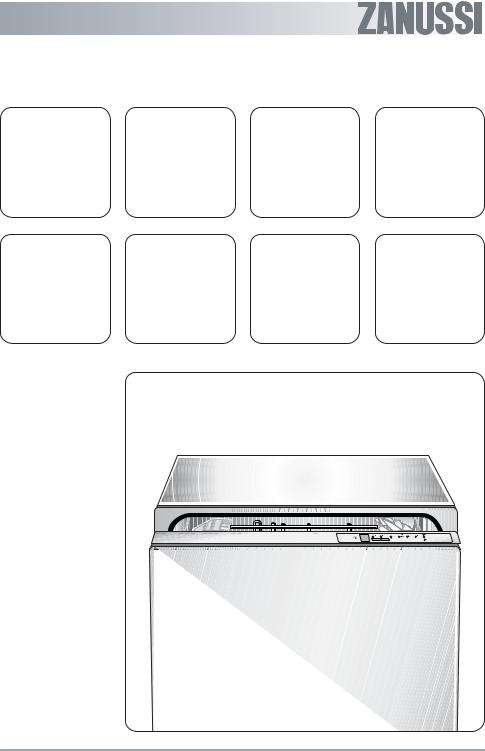
User manual |
Benutzer- |
Notice |
Gebruiks- |
|
information |
d'utilisation |
aanwijzing |
||
|
Dishwasher |
Geschirrspül- |
Lave-vaisselle |
Afwasmachine |
|
maschine |
||||
|
|
|
ZDT111

Thank you for selecting our appliance
We wish you lots of enjoyment with your new appliance and we hope that you will consider our brand again when purchasing household appliances.
Please read this user manual carefully and keep it throughout the product life cycle as a reference document. The user manual should be passed on to any future owner of the appliance.
Contents
Safety information _ _ _ _ _ _ _ _ _ _ _ _ _ 3 Control panel _ _ _ _ _ _ _ _ _ _ _ _ _ _ _ 4 Audible signals _ _ _ _ _ _ _ _ _ _ _ _ _ _ 6 Washing programmes _ _ _ _ _ _ _ _ _ _ _ 7 First use _ _ _ _ _ _ _ _ _ _ _ _ _ _ _ _ _ _ 7 Set the water softener _ _ _ _ _ _ _ _ _ _ _ 8 Use of dishwasher salt _ _ _ _ _ _ _ _ _ _ 10 Use of rinse aid _ _ _ _ _ _ _ _ _ _ _ _ _ _ 11 Adjusting the dosage of rinse aid _ _ _ _ 11 Loading cutlery and dishes _ _ _ _ _ _ _ 12
Use of detergent _ _ _ _ _ _ _ _ _ _ _ _ _ 14 Unloading the dishwasher _ _ _ _ _ _ _ _ 15 Care and cleaning _ _ _ _ _ _ _ _ _ _ _ _ 15 Environment concerns _ _ _ _ _ _ _ _ _ _ 17 Something not working _ _ _ _ _ _ _ _ _ 17 Consumption values _ _ _ _ _ _ _ _ _ _ _ 19 Technical data _ _ _ _ _ _ _ _ _ _ _ _ _ _ 20 Hints for test institutes _ _ _ _ _ _ _ _ _ _ 20 Installation _ _ _ _ _ _ _ _ _ _ _ _ _ _ _ _ 21
Subject to change without notice
2

Safety information
In the interest of your safety and to ensure the correct use, before installing and first using the appliance, read this user manual carefully, including its hints and warnings. To avoid unnecessary mistakes and accidents, it is important to ensure that all people using the appliance are thoroughly familiar with its operation and safety features. Save these instructions and make sure that they remain with the appliance if it is moved or sold, so that everyone using it through its life will be properly informed on appliance use and safety.
Correct use
•This dishwasher is only intended for washing household utensils suitable for machine washing.
•Do not put any solvents in the dishwasher. This could cause an explosion.
•Knives and other items with sharp points must be loaded in the cutlery basket with their points down or placed in a horizontal position in the upper basket.
•Only use products (detergent, salt and rinse aid) suitable for dishwashers.
•Avoid opening the door whilst the appliance is in operation, hot steam may escape.
•Do not take any dishes out of the dishwasher before the end of the dishwashing cycle.
•After use, isolate the appliance from the power supply and turn off the water supply.
•This product should be serviced only by an authorised service engineer, and only genuine spare parts should be used.
•Under no circumstances should you attempt to repair the machine yourself. Repairs car-
ried out by inexperienced persons will cause injury or serious malfunctioning. Contact your local Service Force Centre. Always insist on genuine spare parts.
General safety
•Dishwasher detergents can cause chemical burns to eyes, mouth and throat. Could endanger life! Comply with the safety instructions of the dishwasher detergent manufacturer.
•The water in your dishwasher is not for drinking. Detergent residues may still be present in your machine.
•Ensure that the door of the dishwasher is always closed when it is not being loaded or unloaded. In this way you will avoid anybody tripping over the open door and hurting themselves.
•Do not sit or stand on the open door.
Child safety
•This appliance is designed to be operated by adults. Don’t allow children to use the dishwasher unsupervised.
•Keep all packaging well away from children. There is risk of suffocation.
•Keep all detergents in a safe place out of children’s reach.
•Keep children well away from the dishwasher when the door is open.
3
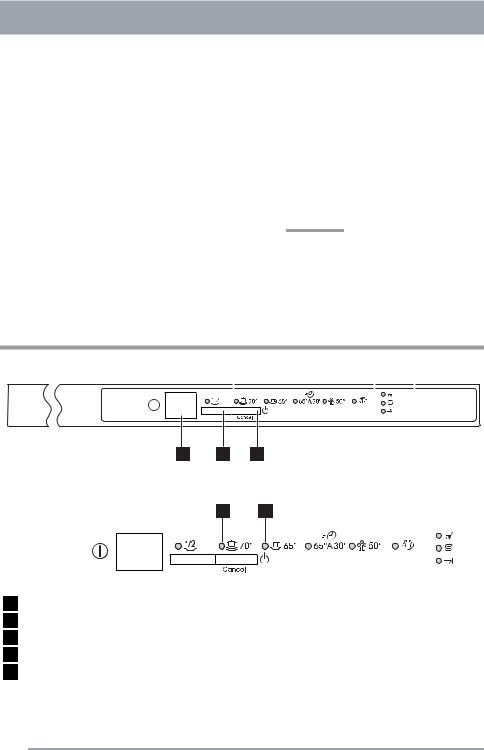
Installation
•Check your dishwasher for any transport damage. Never connect a damaged machine. If your dishwasher is damaged contact your supplier.
•All packaging must be removed before use.
•Any electrical and plumbing work required to install this appliance must be carried out by a qualified and competent person.
•For safety reasons it is dangerous to alter the specifications or attempt to modify this product in any way.
•Never use the dishwasher if the electrical supply cable and water hoses are damaged;
Control panel
or if the control panel, work top or plinth area are damaged such that the inside of the appliance is freely accessible. Contact your local Service Force centre, in order to avoid hazard.
•All sides of the dishwasher must never be drilled to prevent damage to hydraulic and electric components.
 WARNING!
WARNING!
For electrical and water connection carefully follow the instructions given in specific paragraphs.
|
|
|
|
|
|
|||
5 |
|
|
4 |
|||||
|
|
|
|
|
|
|
|
|
|
|
|
|
|
|
|
|
|
|
|
|
|
|
|
|
|
|
|
|
|
|
|
|
|
|
|
|
|
|
|
|
|
|
|
|
|
|
|
|
|
|
|
|
|
1 2 3
A B
1On-Off button
2Half load button
3Programme selection/cancel button
4Indicator lights
5Programme lights
4

Setting mode
The appliance is in setting mode when all programme lights are off and End of programme light flashes.
IMPORTANT!
Always remember that when performing operations such as:
•selecting a washing programme
•setting the water softener
•deactivation/activation of the audible signals
Half load button
Programme selection/cancel button
the appliance MUST be in setting mode.
If a programme light is illuminated and End of programme light is illuminated with fixed light, the last performed programme is still set.
In this case the programme has to be cancelled:
1.Press and hold the Programme selection/ Cancel button until the light of the running programme turns off and the End of programme light is flashing.
2.Release the Programme selection/Cancel button.
The option must be linked to the selection of a washing programme. (See "Programme table" chart). When selected, the corresponding light illuminates.
Load dishes in both baskets (lower and upper). When using the option reduce the dosage of detergent which is normally used for a complete load.
• Starting the washing programme:
1.Press the On-Off button.
2.Press the Programme selection/cancel button once, the light of the last performed washing programme illuminates and the End of programme light flashes.
3.Press the Programme selection/cancel button as many times as necessary to illuminate the light corresponding to the desired programme.
4.Close the dishwasher’s door, the programme will start automatically.
IMPORTANT!
Once the programme has started, if you want to change the selection made you must cancel the washing programme in progress.
• Cancel the washing programme in progress:
1.Open the door.
2.Press and hold the Programme selection/cancel button until the light of the running programme
5

|
|
turns off and the End of programme light is flash- |
|
|
ing. |
|
|
3. Release the Programme selection/cancel but- |
|
|
ton. |
|
|
4. Switch off the machine by pressing the On-Off |
|
|
button or select a new washing programme (check |
|
|
that there is detergent in the detergent dispenser. |
|
|
|
|
Indicator lights |
|
Wash indicator light |
|
Illuminates when the washing, rinsing and drying and |
|
|
phases are running. |
Saltindicator light |
|
Illuminates when the special salt has run out. |
|
|
Is never illuminated while a washing programme is |
|
|
running. |
End of programmeindicator light |
|
Illuminates when the washing programme has ended. |
|
|
It also has added functions of visual signalling as: |
|
|
– the setting of the water softener, |
|
|
– deactivation/activation of the audible signals, |
|
|
– intervention of an alarm due to the malfunction of |
|
|
the machine. |
Audible signals
Audible signals have been introduced to help indicate which operations the dishwasher is performing.
–end of the washing programme,
–malfunction of the appliance
Factory setting: audible signals activated.
It is possible to deactivate the audible signals, using the Programme selection/Cancel button.
Deactivation/activation of the audible signals
1.Press the On/Off button. The appliance must be in setting mode.
2.Press and hold Programme selection/ Cancel button until programme light A
flashes and programme light B illuminates with fixed light.
3.Press Programme selection/Cancel button again: programme light A becomes fixed and programme light B starts flashing.
4.After a few seconds:
–programme light A turns off
–programme light B goes on flashing
–End of programme light illuminates with fixed light, indicating that the audible signals are active.
5.To deactivate the audible signals press again the Programme selection/Cancel button: the End of programme light turns
6
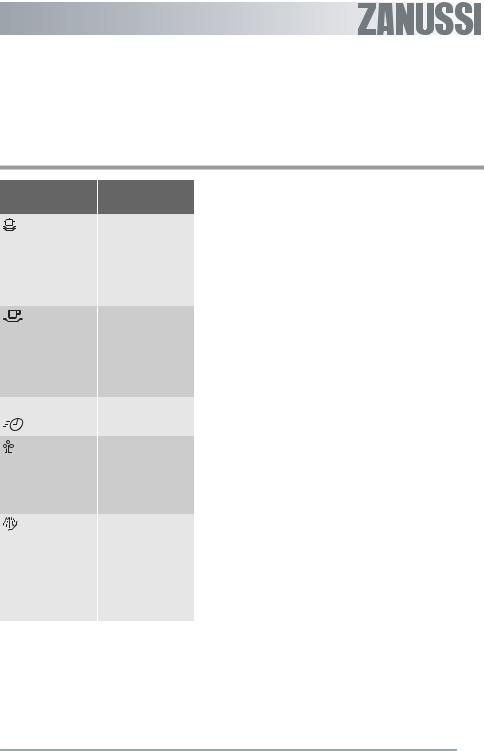
off indicating that the audible signals have been deactivated.
6.To memorise the operation, switch off the dishwasher.
7.To activate again the audible signals, simply follow the above operations until the End of programme indicator light illuminates.
Washing programmes
Programme
70°
65°
65° A 30'2)
50° 3)
Half load
Yes 1)
Yes 1)
No
Yes4)
No
Degree of soil |
Type of load |
Programme de- |
|
|
scription |
Heavy soil |
Crockery, cutlery, |
Prewash |
|
pots and pans |
Main wash |
|
|
2 intermediate rin- |
|
|
ses |
|
|
Final rinse |
|
|
Drying |
Normal soil |
Crockery, cutlery, |
Prewash |
|
pots and pans |
Main wash |
|
|
2 intermediate rin- |
|
|
ses |
|
|
Final rinse |
|
|
Drying |
Light soil |
Crockery and cut- |
Main wash |
|
lery |
Final rinse |
|
|
|
Normal soil |
Crockery and cut- |
Prewash |
|
lery |
Main wash |
|
|
1 intermediate rinse |
|
|
Final rinse |
|
|
Drying |
Any. |
|
1 cold rinse (to |
Partial load (to be completed later in the |
avoid food scraps |
|
day). |
|
from sticking to- |
|
|
gether). |
|
|
This programme |
|
|
does not require the |
|
|
use of detergent. |
1)When the Half load button is pressed, the prewash phase will be automatically excluded. In this case the detergent dose for the prewash phase is no longer necessary.
2)Ideal for washing a partially loaded dishwasher. This is perfect daily programme, made to meet the needs of a family of 4 persons who only wish to load breakfast and dinner crockery and cutlery.
3)Test programme for test institutes.
4)When the Half load button is pressed, the duration of the washing phase is reduced.
7

First use
Before using your dishwasher for the first time:
•Ensure that the electrical and water connections comply with the installation instructions
•Remove all packaging from inside the appliance
•Set the water softener
•Pour 1 litre of water inside the salt container and then fill with dishwasher salt
•Fill the rinse aid dispenser
When using tablets that integrate rinse aid and detergent:
there is no need to fill up with rinse aid
–set the water softener
–add special (dishwasher) salt
When using tablets that integrate rinse aid, detergent, salt function and other additives:
there is no need to fill up with special salt or rinse aid.
Set the water softener
Check whether these detergents are suitable for your water hardness. Follow the manufacturers instructions.
– Set the water hardness to level 1.
IMPORTANT!
If the drying results are not satisfactory we recommend that you:
1.Fill up the rinse aid dispenser with rinse aid.
2.Set the rinse aid dosage to position 2.
If you decide in future to use separated detergents, we advise that you:
–Fill up the salt and rinse aid container.
–Adjust the water hardness setting to the highest level and perform 1 normal washing programme without loading any dishes.
–Adjust the water hardness setting according to the hardness of the water in your area.
–Adjust the rinse aid dosage
The dishwasher is equipped with a water softener designed to remove minerals and salts from the water supply, which would have a detrimental or adverse effect on the operation of the appliance.
The higher the content of these minerals and salts, the harder your water is. Water hardness is measured in equivalent scales, German de-
grees (°dH), French degrees (°TH) and mmol/ l (millimol per litre - international unit for the hardness of water).
The softener should be adjusted according to the hardness of the water in your area. Your local Water Authority can advise you on the hardness of the water in your area.
8
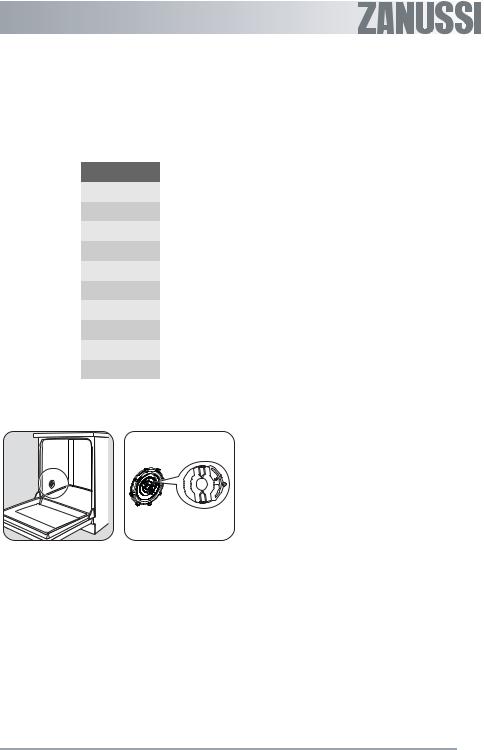
The water softener must be set in both ways: manually and electronically.
|
Water hardness |
|
Adjusting the water hardness |
Use of salt |
||
|
|
|
setting |
|
||
|
|
|
|
|
||
°dH |
°TH |
mmol/l |
manually |
|
electronically |
|
51 - 70 |
91 - 125 |
9,1 - 12,5 |
2 |
|
level 10 |
yes |
43 - 50 |
76 - 90 |
7,6 - 8,9 |
2 |
|
level 9 |
yes |
37 - 42 |
65 - 75 |
6,51 - 7,5 |
2 |
|
level 8 |
yes |
29 - 36 |
51 - 64 |
5,1 - 6,4 |
2 |
|
level 7 |
yes |
23 - 28 |
40 - 50 |
4,0 - 5,0 |
2 |
|
level 6 |
yes |
19 - 22 |
33 - 39 |
3,3 - 3,9 |
2 |
|
level 5 |
yes |
15 - 18 |
26 - 32 |
2,61 - 3,2 |
1 |
|
level 4 |
yes |
11 - 14 |
19 - 25 |
1,9 - 2,5 |
1 |
|
level 3 |
yes |
4 - 10 |
7 - 18 |
0,71 - 1,8 |
1 |
|
level 2 |
yes |
< 4 |
< 7 |
< 0,7 |
1 |
|
level 1 |
no |
|
|
|
|
|
|
|
Setting the water softener manually (see table)
The water softener is factory set at position 2.
Set switch to position 1 or 2
Setting the water softener electronically (see table)
The water softener is factory set at position 5.
1.Press the On/Off button. The appliance must be in setting mode.
2.Press and hold Programme selection/ Cancel button until programme light A flashes and programme light B illuminates with fixed light.
9
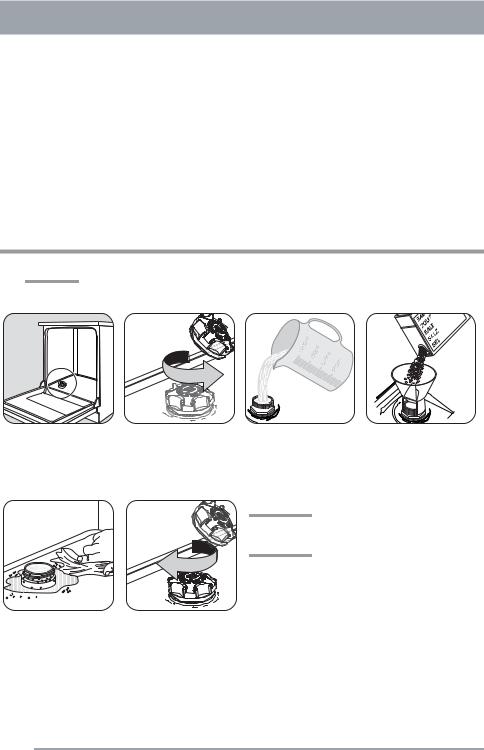
3.After a few seconds:
–programme light B turns off
–programme light A goes on flashing
–End of programme light starts flashing: the number of flashes corresponds to current level set. The flashing is repeated with a pause of a few seconds. Examples: 5 flashes, pause, 5 flashes, pause, etc... = level 5.
4.To change the level, press the Programme selection/Cancel button. Each time the button is pressed the level increases (level 1 follows level 10). The End of programme light indicates the new setting.
5.To memorise the operation, switch off the dishwasher.
Use of dishwasher salt
 CAUTION!
CAUTION!
Use only special salt suitable for dishwashers.
Unscrew the cap.
Remove any trace of salt. Replace the cap tightly turning it clockwise until it stops with a click.
Only before filling with |
Using the funnel provided, |
salt for the first time, fill |
pour in the salt until the |
the salt container with wa- |
container is filled with salt. |
ter. |
|
IMPORTANT!
Immediately start a complete programme.
IMPORTANT!
Water will overflow from the container as salt is added.
10
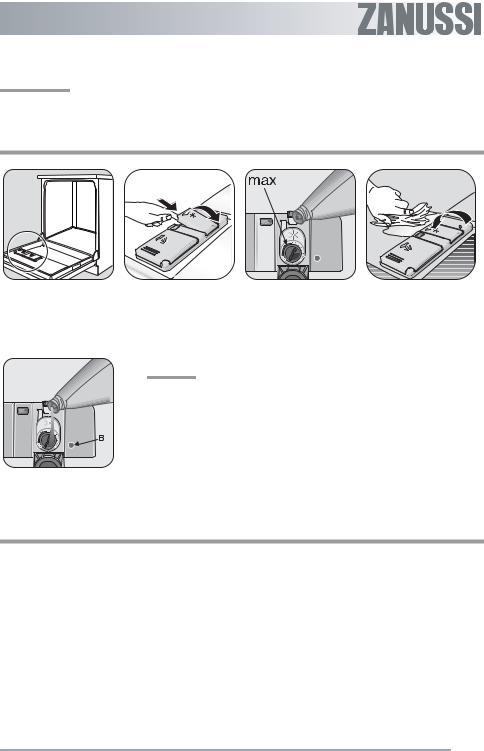
IMPORTANT!
Top up the special salt when the light on the control panel illuminates.
Use of rinse aid
|
|
|
|
|
|
|
|
|
|
|
|
|
|
|
|
|
|
|
|
|
|
|
|
|
|
|
|
|
|
|
|
|
|
|
|
|
|
|
|
|
|
|
|
|
|
|
|
|
|
|
|
|
|
|
|
|
|
|
|
|
|
|
|
|
|
|
|
|
|
|
|
|
|
|
|
|
|
|
|
|
|
|
|
|
|
|
|
|
|
|
|
|
|
|
|
|
|
|
|
|
|
|
|
|
|
|
|
|
|
|
|
Open the lid. |
Fill up with rinse aid. The |
||||||
|
|
maximum level for filling is |
|||||
|
|
indicated by "max" |
|||||
Clean up any rinse aid which overflows. Close the lid and press until it locks.
 CAUTION!
CAUTION!
Never fill the rinse aid dispenser with any other substances (e.g. dishwasher cleaning agent, liquid detergent). This would damage the appliance.
Top up the rinse aid indicator (B) becomes clear
Adjusting the dosage of rinse aid
Increase the dose if there are drops of water or lime spots on the dishes after washing.
Reduce the dose if there are whitish streaks on the dishes or a bluish film on glassware or knife blades.
11
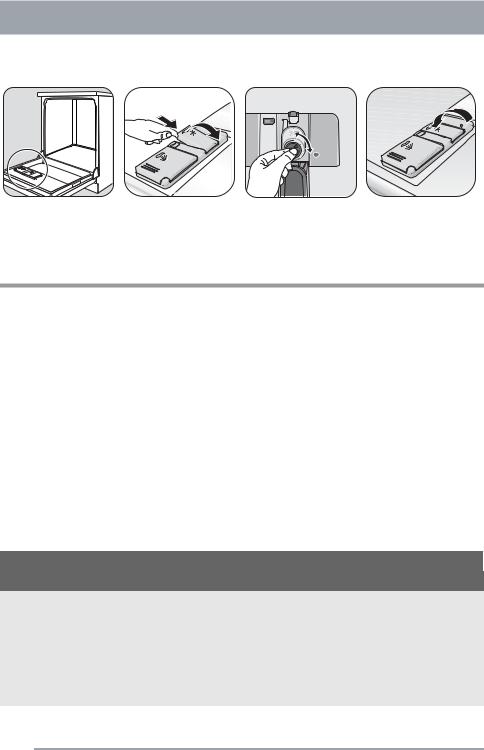
|
|
|
|
|
|
|
|
|
|
|
|
|
|
|
|
|
|
|
|
|
|
|
|
|
|
|
|
|
|
|
|
|
|
|
|
|
|
|
|
|
|
|
|
|
|
|
|
|
|
|
|
|
|
|
|
|
|
|
|
|
|
|
|
|
|
|
|
|
|
|
|
|
|
|
|
|
|
|
|
|
|
|
|
|
|
|
|
|
|
|
|
|
|
|
|
|
|
|
|
|
|
|
|
|
|
|
|
|
|
|
|
|
|
|
|
|
|
|
|
|
|
|
|
|
|
|
|
|
|
|
|
|
|
|
|
|
|
|
|
|
|
|
|
|
|
|
|
|
|
|
|
|
|
|
|
|
|
|
|
|
|
|
|
|
|
|
|
|
|
|
|
|
|
|
|
|
|
|
|
|
|
Open the lid. |
Set the dosage level. (The |
Close the lid and press un- |
||||||||||
|
|
dose is factory set in po- |
til it locks. |
|||||||||
|
|
sition 4). |
|
|
||||||||
Loading cutlery and dishes
Sponges, household cloths and any object that can absorb water may not be washed in the dishwasher.
•Before loading the dishes, you should:
–Remove all left over food and debris.
–Soften remnants of burnt food in pans
•When loading the dishes and cutlery, please note:
–Dishes and cutlery must not impede the rotation of the spray arms.
–Load hollow items such as cups, glasses, pans, etc. with the opening downwards so that water cannot collect in the container or a deep base.
–Dishes and items of cutlery must not lie inside one another, or cover each other.
–To avoid damage to glasses, they must not touch.
–Lay small objects in the cutlery basket.
•Plastic items and pans with non stick coatings have a tendency to retain water drops; these items will not dry as well as porcelain and steel items.
•Light items (plastic bowls etc.) must be loaded in the upper basket and arranged so they do not move.
For washing in the dishwasher the following cutlery and dishes
are not suitable:
•Cutlery with wooden, horn, china or mother-of- pearls handles.
•Plastic items that are not heat resistant.
•Older cutlery with glued parts that are not temperature resistant.
•Bonded cutlery items or dishes.
•Pewter or copper items.
are of limited suitability:
•Only wash stoneware in the dishwasher if it is specially marked as being dishwasher-safe by the manufacturer.
•Glazed patterns may fade if machine washed frequently.
12
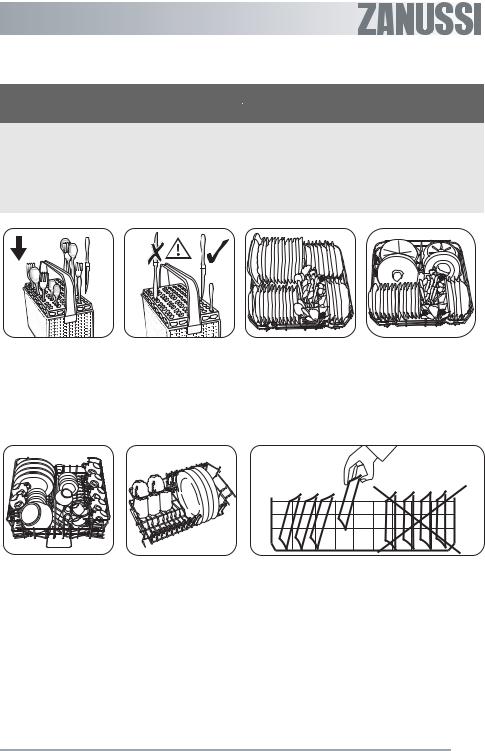
For washing in the dishwasher the following cutlery and dishes
are not suitable:
•Lead crystal glass.
•Steel items prone to rusting.
•Wooden platters.
•Items made from synthetics fibres.
Load cutlery. For best results we recommend you to use the cutlery grid provided (if the size and dimensions of the cutlery allow it)
Load upper basket. Light items (plastic bowls etc.) must be loaded in the upper basket and arranged so they do not move.
Place knives and other items of cutlery with sharp points or edges with their handles facing upwards. Risk of injury!
For taller items, the cup racks can be folded upwards.
are of limited suitability:
•Silver and aluminium parts have a tendency to discolour during washing: Residues, e.g. egg white, egg yolk and mustard often cause discolouring and staining on silver. Therefore always clean left-overs from silver immediately, if it is not to be washed straight after use.
Load the lower basket. Arrange serving dishes and large lids around the edge of the basket.
If plates are to be loaded in the upper basket: load them starting from the rear positions; tilting them slightly forwards and avoiding the front positions near the door.
13
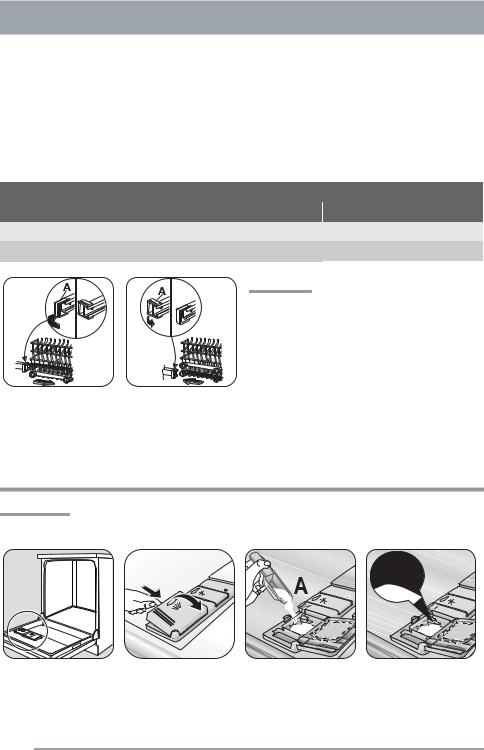
Adjusting the height of the upper basket
If washing very large plates you can load them in the lower basket after moving the upper basket to the higher position.
Maximum height of the dishes in:
|
upper basket |
lower basket |
With upper basket raised |
20 cm |
31 cm |
With upper basket lowered |
24 cm |
27 cm |
|
IMPORTANT! |
|
|
When the basket is in the higher position you will not |
|
|
be able to use the cup racks. |
|
Move the front runner stops (A) of the upper basket outwards and slide the basket out.
Refit the basket in the higher position and replace the stops (A) in their original position.
Use of detergent
IMPORTANT!
Only use detergents suitable for dishwashers.
Observe the manufacturer’s dosing and storage recommendations.
Open the lid. |
Fill in the detergent in |
Observe the dosing lev- |
|
compartment A. |
els. |
14
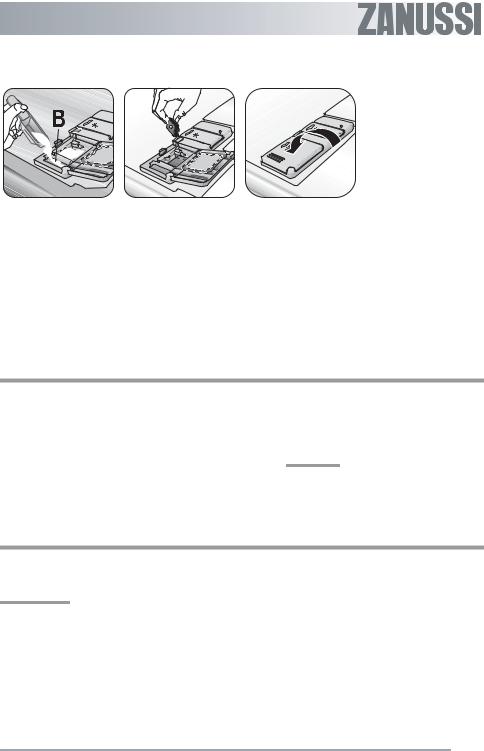
|
|
|
|
|
|
|
|
|
|
|
|
|
|
|
|
|
|
|
|
|
|
|
|
For programmes with pre- |
When using detergent |
Close the lid. |
|||
wash add an additional |
tablets: place detergent |
|
|||
detergent dose in com- |
tablets in compartment A. |
|
|||
partmentB. |
|
|
|
||
Detergent tablets
Detergent tablets from different manufacturers dissolve at different rates. For this reason, some detergent tablets do not attain their full
cleaning power during short washing programmes. Therefore, please use long washing programmes when using detergent tablets, to ensure the complete removal of detergent residuals.
Unloading the dishwasher
•Hot dishes are sensitive to knocks.
The dishes should therefore be allowed to cool down before removing from the appliance.
•Empty the lower basket first and then the upper one; this will avoid water dripping from the upper basket onto the dishes in the lower one.
•Water may appear on the sides and the door of the dishwasher as the stainless steel will eventually become cooler than the dishes.
 CAUTION!
CAUTION!
When the washing programme has finished, it is recommended that the dishwasher is unplugged and the water tap turned off.
Care and cleaning
Cleaning the filters
IMPORTANT!
NEVER use the dishwasher without filters. Incorrect repositioning and fitting of the filters will produce poor washing results.
15
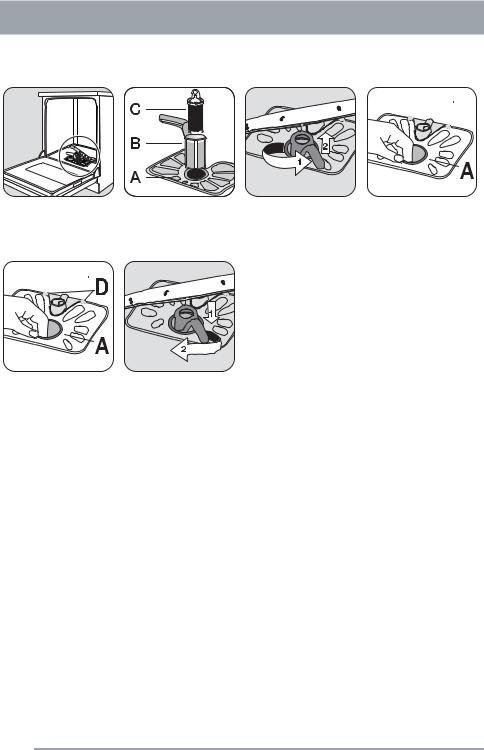
Clean filters A, B and C thoroughly under running water.
|
|
|
|
|
|
|
|
|
|
|
|
|
|
|
|
|
|
|
|
|
|
|
|
|
|
|
|
|
|
|
|
|
|
|
|
|
|
|
|
|
|
|
|
|
|
|
|
|
|
|
|
|
|
|
|
|
|
|
|
|
|
|
|
|
|
|
|
|
|
|
|
Put the flat filter A back in |
Replace the filters and |
||||||
the base of the washing |
lock by turning the handle |
||||||
compartment and ensure |
clockwise to the stop. |
||||||
that it fits perfectly under |
|
|
|
|
|
||
the two guidesD. |
|
|
|
|
|
||
|
|
|
|
|
|
|
|
|
|
|
|
|
|
|
|
|
|
|
|
|
|
|
|
|
|
|
|
|
|
|
|
|
|
|
|
|
|
|
|
|
|
|
|
|
|
|
|
|
|
|
|
|
|
|
|
|
|
|
|
|
|
|
|
|
|
Turn the handle about 1/4 |
Remove filter A from the |
||||
turn anticlockwise and re- |
base of the washing com- |
||||
move filters B and C. |
partment. |
||||
Cleaning the spray arms
NEVER try to remove the spray arms.
If residues of soil have clogged the holes in the spray arms, remove them with a cocktail stick.
External cleaning
Clean the external surfaces of the machine and control panel with a damp soft cloth. If necessary use only neutral detergents. Never use abrasive products, scouring pads or solvent (acetone, trichloroethylene etc....).
16
Internal cleaning
Ensure that the seals around the door, the detergent and rinse aid dispensers are cleaned regularly with a damp cloth.
We recommend every 3 months to run the wash programme for heavy soiled dishes using detergent but without dishes.
Prolonged periods of nonoperation
If you are not using the machine for any prolonged period of time you are advised to:
1.Unplug the appliance and then turn off the water.

2.Leave the door ajar to prevent the formation of any unpleasant smells.
3.Leave the inside of the machine clean.
Frost precautions
Avoid placing the machine in a location where the temperature is below 0°C. If this is unavoidable, empty the machine, close the appliance door, disconnect the water inlet pipe and empty it.
1.Unplug it.
2.Turn the water tap off.
3.Remove the water inlet and discharge hoses.
4.Pull the machine out together with the hoses.
Avoid over tilting the machine during transportation.
Moving the machine
If you have to move the machine (moving house etc....):
Environment concerns
The symbol  on the product or on its packaging indicates that this product may not be treated as household waste. Instead it should be taken to the appropriate collection point for the recycling of electrical and electronic equipment. By ensuring this product is disposed of correctly, you will help prevent potential negative consequences for the environment and human health, which could otherwise be caused by inappropriate waste handling of this product. For more detailed information about recycling of this product, please contact your local council, your household waste disposal service or the shop where you purchased the product.
on the product or on its packaging indicates that this product may not be treated as household waste. Instead it should be taken to the appropriate collection point for the recycling of electrical and electronic equipment. By ensuring this product is disposed of correctly, you will help prevent potential negative consequences for the environment and human health, which could otherwise be caused by inappropriate waste handling of this product. For more detailed information about recycling of this product, please contact your local council, your household waste disposal service or the shop where you purchased the product.
ponents are identified by markings, e.g. >PE<, >PS<, etc. Please dispose of the packaging materials in the appropriate container at the community waste disposal facilities.
 CAUTION!
CAUTION!
When a unit is no longer being used:
•Pull the plug out of the socket.
•Cut off the cable and plug and dispose of them.
•Dispose of the door catch. This prevents children from trapping themselves inside and endangering their lives.
Packaging material
The packaging materials are environmentally friendly and can be recycled. The plastic com-
17

Something not working
The dishwasher will not start or stops during operation.
Certain problems are due to the lack of simple maintenance or oversights, which can be
solved with the help of the indications described in the chart, without calling out an engineer. Switch off the dishwasher and carry out the following suggested corrective actions.
Fault code and malfunction
•continuous flashing of the start/cancel indicator light
•1 intermittent audible signal
•1 flash of the "end of cycle" indicator light
The dishwasher does not fill with water.
•continuous flashing of the start/cancel indicator light
•2 intermittent audible signals
•2 flashes of the "end of cycle" indicator light
The dishwasher will not drain.
•continuous flashing of the start/cancel indicator light
•3 intermittent audible signals
•3 flashes of the "end of cycle" indicator light
The programme does not start.
Possible cause and solution
•The water tap is blocked or furred with limescale. Clean the water tap.
•The water tap is turned off. Turn the water tap on.
•The filter (where present) in the threaded hose fitting at the water inlet valve is blocked.
Clean the filter in the threaded hose fitting.
•The water inlet hose has not been correctly laid or it is bent or squashed.
Check the water inlet hose connection.
•The sink spigot is blocked. Clean out the sink spigot.
•The water drain hose has not been correctly laid or it is bent or squashed.
Check the water drain hose connection.
•Anti-flood device is activated.
Close the water tap and contact your local Service Force Centre.
•The dishwasher door has not been properly closed. Close the door.
•The main plug is not plugged in. Insert the mains plug.
•The fuse has blown in the household fuse box. Replace the fuse.
Once these checks have been carried out; switch on the dishwasher. The programme will continue from the point at which it was interrupted.
If the malfunction or fault code reappears contact the Service Force Centre.
18
For other fault codes not described in the above chart, please contact your Service Force Centre.
Contact your local Service Force Centre, quoting the model (Mod.), product number (PNC) and serial number (S.N.). This information can

be found on the rating plate located on the side of the dishwasher door.. So that you always
Mod. :. . . . . . . . . . . . . . . . . . . . . . . . . . . . . .
PNC : . . . . . . . . . . . . . . . . . . . . . . . . . . . . . .
S.N. : . . . . . . . . . . . . . . . . . . . . . . . . . . . . . .
have these numbers at hand, we recommend you to make a note of them here:
The wash results are not satisfactory
The dishes are not clean
The dishes are wet and dull
There are streaks, milky spots or a bluish coating on glasses and dishes
Water drops have dries onto glasses and dishes
•The wrong washing programme has been selected.
•The dishes are arranged in such a way as to stop water reaching all parts of the surface. The baskets must not be overloaded.
•The spray arms do not rotate freely due to incorrect arrangement of the load.
•The filters in the base of the washing compartment are dirty or incorrectly positioned.
•Too little or no detergent has been used.
•Where there are limescales deposits on the dishes; the salt container is empty or the incorrect level of the water softener has been set.
•The drain hose connection is not correct.
•The salt container cap is not properly closed.
•Rinse aid was not used.
•The rinse aid dispenser is empty.
•Decrease rinse aid dosing.
•Increase rinse aid dosing.
•The detergent may be the cause. Contact the detergent manufacturer’s consumer care line.
If after all these checks, the problem persists, contact your local Service Force Centre.
Consumption values
The consumption values are intended as a guide and depends on the pressure and the temperature of the water and also by the var-
iations of the power supply and the amount of dishes.
19

Consumption values
Programme |
Programme duration (in |
Energy consumption (in |
|
Water (litres) |
|||
|
minutes) |
|
kWh) |
|
|
||
|
85-95 |
|
1,8-2,0 |
|
|
22-25 |
|
70° |
|
|
|
|
|
|
|
|
105-115 |
|
1,5-1,7 |
|
|
23-25 |
|
65° |
|
|
|
|
|
|
|
|
30 |
|
0,9 |
|
|
9 |
|
65° A 30' |
|
|
|
|
|
|
|
|
130-140 |
|
1,0- 1,2 |
|
|
14-16 |
|
50° (Test programme |
|
|
|
|
|
|
|
for Test Institutes) |
|
|
|
|
|
|
|
|
12 |
|
0,1 |
|
|
5 |
|
|
|
|
|
|
|
|
|
Technical data |
|
|
|
|
|
|
|
|
|
|
|
|
|||
Dimensions |
|
Width x Height x Depth (cm) |
|
59,6 x 81,8-87,8 x 55,5 |
|||
Electrical connection |
|
Information on the electrical connection is given on the rating plate on the |
|||||
Voltage - Overall power - Fuse |
inner edge of the dishwasher’s door. |
|
|||||
Water supply pressure |
|
Minimum - Maximum |
|
0,05 - 0,8 |
|
||
|
|
(MPa) |
|
|
|
|
|
Capacity |
|
place settings |
|
12 |
|
|
|
|
|
|
|
|
|
|
|
Hints for test institutes
Testing in accordance with EN 60704 must be carried out with appliance fully loaded and using the test programme (see "Consumption values").
Test in accordance with EN 50242 must be carried out when the salt container and rinse
aid dispenser have been filled with salt and rinse aid respectively and using the test programme (see "Consumption values").
|
Full load: 12 standard place settings |
|
Amount of detergent required |
|
5 g + 25 g (Type B) |
|
|
|
20

|
|
|
|
|
|
Full load: 12 standard place settings |
|||||||
Rinse aid setting |
|
|
|
|
|
position 4 (Type III) |
|||||||
|
|
|
|
|
|
|
|
|
|
|
|
|
|
|
|
|
|
|
|
|
|
|
|
|
|
|
|
|
|
|
|
|
|
|
|
|
|
|
|
|
|
|
|
|
|
|
|
|
|
|
|
|
|
|
|
|
|
|
|
|
|
|
|
|
|
|
|
|
|
|
|
|
|
|
|
|
|
|
|
|
|
|
|
|
|
|
|
|
|
|
|
|
|
|
|
|
|
|
|
|
|
|
|
|
|
|
|
|
|
|
|
|
|
|
|
|
|
|
|
|
|
|
|
|
|
|
|
|
|
|
|
|
|
|
|
|
|
|
|
Upper basket |
|
|
|
|
|
|
Cutlery basket |
Lower basket |
|||||||||
|
|
|
|
|
|
|
|
|
|
|
|
|
|
|
|
|
|
|
|
|
|
|
|
|
|
|
|
|
|
|
|
|
|
|
|
|
|
|
|
|
|
|
|
|
|
|
|
|
|
|
|
|
|
|
|
|
|
|
|
|
|
|
|
|
|
|
|
|
|
|
|
|
|
|
|
|
|
|
|
|
|
|
|
|
|
|
|
|
|
|
|
|
|
|
|
|
|
|
|
|
|
|
|
|
|
|
|
cup racks: position A
Installation
 WARNING!
WARNING!
Any electrical and/or plumbing work required to install this appliance should be carried out by a qualified electrician and/or plumber or competent person.
Water connection
 WARNING!
WARNING!
This appliance can be connected to either a hot (max. 60°) or cold water supply.
With a hot water supply you can have a significant reduction of energy consumption. This however, depends on how the hot water is produced. (We suggest alternative sources of en-
ergy that are more environmentally friendly as e.g. solar or photovoltaic panels and aeolian).
 WARNING!
WARNING!
Only use, for connection to the water mains, new hose-set; old hose-set must not be reused.
 CAUTION!
CAUTION!
If the machine is connected to new pipes or pipes which have not been used for a long time, you should run the water for a few minutes before connecting the inlet hose.
21
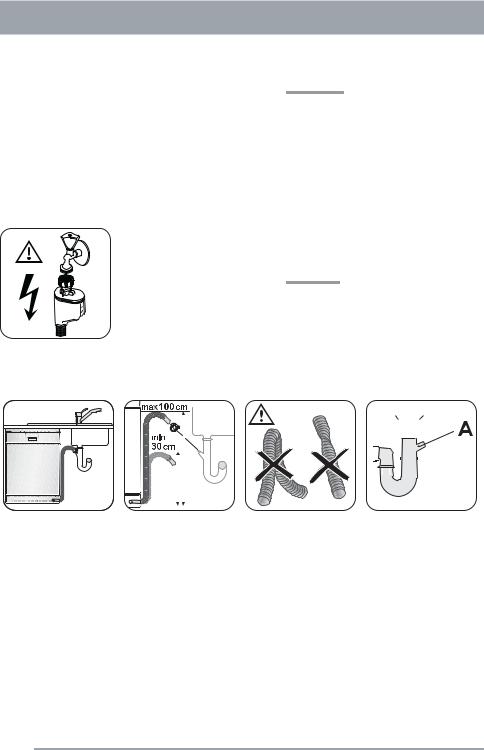
Water inlet hose with safety valve
Connect the inlet hose to a water tap with an external thread of 3/4”.
After connecting the double-walled water inlet hose, the safety valve is next to the tap.
If the water inlet hose leaks, the safety valve cuts off the water supply.
 WARNING!
WARNING!
The electrical cable for the safety valve is in the double-walled water inlet hose and is live. Therefore do not immerse the water inlet hose or the safety valve in water.
Take care when installing the water inlet hose
. Place the water inlet hose in such a way that it is always lower than the bottom edge of the safety valve.
If the water inlet hose or the safety valve is damaged, remove the mains plug immediately.
 CAUTION!
CAUTION!
A water inlet hose with safety valve MUST only be replaced by your local Service Force Centre.
Drain hose
|
|
|
|
|
|
|
|
|
|
|
|
|
|
|
|
|
|
|
|
|
|
|
|
|
|
|
|
|
|
|
|
|
|
|
|
|
|
|
|
|
|
|
|
|
|
|
|
|
|
|
|
|
|
|
|
|
|
|
|
|
|
|
|
|
|
|
|
|
|
|
|
|
|
|
|
|
|
|
|
|
|
|
|
|
|
|
|
|
|
|
|
|
|
|
|
|
|
|
|
|
|
|
|
|
|
|
|
|
|
|
|
|
|
|
|
|
|
|
|
|
|
|
|
|
|
|
|
|
|
|
|
|
|
|
|
|
|
|
|
|
|
|
|
|
|
|
|
|
|
|
|
|
|
|
|
|
|
|
|
|
|
|
|
|
|
|
|
|
|
|
|
|
|
|
|
|
|
|
|
|
|
|
|
|
|
|
|
|
|
|
|
|
|
|
|
|
|
|
|
|
|
|
|
|
|
|
|
|
|
|
|
|
|
|
|
|
|
|
|
|
|
|
|
|
|
|
|
|
|
|
|
|
|
|
|
|
|
|
|
|
|
|
|
|
|
|
|
|
|
|
|
Connect drain hose to the |
Required height: 30 to 100 |
Ensure that the hoses are |
When connecting the |
|||||||||||||||||
sink. |
cm above bottom of the |
not kinked, crushed or en- |
drain hose to an under |
|||||||||||||||||
|
|
|
|
|
|
|
|
|
dishwasher. |
tangled. |
sink trap spigot, the entire |
|||||||||
|
|
|
|
|
|
|
|
|
|
|
|
|
|
|
|
plastic membrane (A) |
||||
|
|
|
|
|
|
|
|
|
|
|
|
|
|
|
|
must be removed. Fail- |
||||
|
|
|
|
|
|
|
|
|
|
|
|
|
|
|
|
ure to remove all the mem- |
||||
|
|
|
|
|
|
|
|
|
|
|
|
|
|
|
|
brane will result in food |
||||
|
|
|
|
|
|
|
|
|
|
|
|
|
|
|
|
particles building up over |
||||
|
|
|
|
|
|
|
|
|
|
|
|
|
|
|
|
time eventually blocking |
||||
|
|
|
|
|
|
|
|
|
|
|
|
|
|
|
|
the dishwasher drain hose |
||||
|
|
|
|
|
|
|
|
|
|
|
|
|
|
|
|
spigot. |
||||
If you use a drain hose extension the total length should not be longer than 4 metres.
22
Likewise the internal diameter of the couplings used for connections to the waste outlet must

be no smaller than the diameter of the hose provided.
 CAUTION!
CAUTION!
To avoid water leakage after installation make sure that the water couplings are tight.
Electrical connection
 CAUTION!
CAUTION!
Safety standards require the appliance to be earthed.
Prior to using the appliance for the first time, ensure that the rated voltage and type of supply on the rating plate match that of the supply where the appliance is to be installed.
The fuse rating is also to be found on the rating plate.
Always plug the mains plug into a correctly installed shockproof socket. Multi-way plugs, connectors and extension cables must not be used.
This could constitute a fire hazard through overheating.
If necessary, have the domestic wiring system socket replaced. In case that the electrical cable has to be replaced, contact your local Service Force centre.
The plug must be accessible after the appliance has been installed.
Never unplug the appliance by pulling on the cable. Always pull the plug.
The manufacturer accepts no liability for failure to observe the above safety precautions.
Fitting under a counter
IMPORTANT!
Carefully follow the instructions on the enclosed template for building in the dishwasher and fitting the furniture panel.
 WARNING!
WARNING!
The dishwasher must be secured against tilting. Therefore make sure that the counter it is fixed under, is suitably secured to a fixed structure (adjacent kitchen units cabinets, wall).
This dishwasher is designed to be fitted under a kitchen counter or work surface.
No further openings for the venting of the dishwasher are required, but only to let the water fill and drain hose and power supply cable pass through.
The dishwasher incorporates adjustable feet to allow the adjustment of the height.
During all operations that involve accessibility to internal components the dishwasher has to be unplugged.
Be sure that once the appliance has been installed, it is easily accessible for the service engineer in the event that a repair is required.
Levelling
Good levelling is essential for correct closure and sealing of the door.
When the appliance is correctly levelled, the door will not catch on either side of the cabinet. If the door does not close correctly, loosen or tighten the adjustable feet until the machine is perfectly level. (See enclosed template).
23

Wir danken Ihnen, dass Sie sich für dieses Gerät entschieden haben.
Wir wünschen Ihnen mit Ihrem neuen Gerät viel Freude und hoffen, dass Sie sich auch in Zukunft beim Kauf von Haushaltsgeräten für unsere Produkte entscheiden werden.
Bitte lesen Sie die Benutzerinformation sorgfältig durch und bewahren Sie diese als Referenz auf, solange Sie im Besitz dieses Haushaltsgerätes sind. Die Benutzerinformation sollte an zukünftige Besitzer dieses Gerätes weitergegeben werden.
Inhalt
Sicherheitshinweise _ _ _ _ _ _ _ _ _ _ _ 25 Bedienblende _ _ _ _ _ _ _ _ _ _ _ _ _ _ _ 27 Töne _ _ _ _ _ _ _ _ _ _ _ _ _ _ _ _ _ _ _ 29 Spülprogramme _ _ _ _ _ _ _ _ _ _ _ _ _ 30 Erste Benutzung _ _ _ _ _ _ _ _ _ _ _ _ _ 30 Einstellen des Wasserenthärters _ _ _ _ _ 31
Gebrauch von Salz für
Geschirrspüler _ _ _ _ _ _ _ _ _ _ _ _ _ _ 33 Gebrauch von Klarspülmittel _ _ _ _ _ _ _ 34 Einstellung der Klarspüldosierung _ _ _ _ 35 Laden von Besteck und Geschirr _ _ _ _ 35
Gebrauch von Spülmittel _ _ _ _ _ _ _ _ _ 38 Entladen des Geschirrspülers _ _ _ _ _ _ 39 Reinigung und Pflege _ _ _ _ _ _ _ _ _ _ 39 Umweltschutz _ _ _ _ _ _ _ _ _ _ _ _ _ _ 41 Störung, was tun _ _ _ _ _ _ _ _ _ _ _ _ _ 41 Verbrauchswerte _ _ _ _ _ _ _ _ _ _ _ _ _ 44 Technische Daten _ _ _ _ _ _ _ _ _ _ _ _ 44 Hinweise für Prüfinstitute _ _ _ _ _ _ _ _ _ 44 Aufstellung _ _ _ _ _ _ _ _ _ _ _ _ _ _ _ _ 45
Änderungen vorbehalten
24

Sicherheitshinweise
Lesen Sie zu Ihrer Sicherheit und für die optimale Geräteanwendung vor der Installation und dem Gebrauch des Gerätes die vorliegenden Sicherheitshinweise aufmerksam durch, einschließlich der Ratschläge und Warnungen. Es ist wichtig, dass zur Vermeidung von Fehlern und Unfällen alle Personen, die das Gerät benutzen, mit der Bedienung und den Sicherheitsvorschriften vertraut sind. Heben Sie die Benutzerinformation gut auf und übergeben Sie sie bei einem Weiterverkauf des Gerätes dem neuen Besitzer, so dass jeder während der gesamten Lebensdauer des Gerätes über Gebrauch und Sicherheit informiert ist.
Bestimmungsgemäßer
Gebrauch
•Dieser Geschirrspüler ist nur zum Reinigen von spülmaschinenfestem Haushaltsgeschirr bestimmt.
•Keine Lösungsmittel in den Geschirrspüler geben. Es besteht Explosionsgefahr.
•Messer und andere spitze oder scharfe Gegenstände müssen mit der Spitze nach unten in den Besteckkorb oder waagerecht in den oberen Korb gelegt werden.
•Nur für Geschirrspüler geeignete Produkte (Reinigungsmittel, Salz und Klarspüler) verwenden.
•Die Tür des Gerätes während des Spülvorgangs nicht öffnen. Es kann heißer Dampf entweichen.
•Kein Geschirr vor dem Ende des Spülgangs aus dem Geschirrspüler entnehmen.
•Nach der Benutzung den Netzstecker ziehen und den Wasserhahn zudrehen.
•Servicearbeiten und Reparaturen dürfen an diesem Gerät nur von Fachkräften der autorisierten Kundendienststellen durchgeführt werden, und es sollten stets Original - Ersatzteile verwendet werden.
•Versuchen Sie unter keinen Umständen, das Gerät selbst zu reparieren. Reparaturen durch unerfahrene Personen können zu schwerwiegenden Fehlfunktionen und Verletzungen führen. Wenden Sie sich an Ihren Kundendienst. Bestehen Sie immer auf Ori- ginal-Ersatzteilen.
Allgemeine
Sicherheitshinweise
•Reiniger für Geschirrspüler können Verätzungen in Augen, Mund und Rachen verursachen. Lebensgefahr! Halten Sie sich immer an die Sicherheitsanweisungen der Spülmittelhersteller.
•Das Wasser in Ihrem Geschirrspüler ist kein Trinkwasser. Es können noch Reinigerreste im Gerät vorhanden sein.
•Sorgen Sie dafür, dass die Tür des Geschirrspülers außer beim Beund Entladen immer geschlossen ist. Jemand könnte über die geöffnete Tür stolpern und sich verletzen.
•Setzen oder stellen Sie sich nie auf die offene Tür.
25

Sicherheitsvorkehrungen bei Kindern
•Das Gerät ist für den Gebrauch durch Erwachsene vorgesehen. Kinder dürfen den Geschirrspüler nicht ohne Aufsicht benutzen.
•Lassen Sie das Verpackungsmaterial nicht in die Hände von Kindern gelangen. Erstickungsgefahr!
•Spülmittel außer Reichweite von Kindern aufbewahren.
•Halten Sie Kinder vom geöffneten Geschirrspüler fern.
Aufstellung
•Kontrollieren Sie das Gerät auf Transportschäden. Nehmen Sie niemals ein schadhaftes Gerät in Betrieb. Wenden Sie sich im Fall einer Beschädigung an Ihren Händler.
•Entfernen Sie vor dem Gebrauch das gesamte Verpackungsmaterial.
•Der elektrische Anschluss des Gerätes und alle sonstigen Installationsarbeiten dürfen
26
nur von qualifizierten Fachkräften ausgeführt werden.
•Aus Sicherheitsgründen dürfen keine Änderungen an den technischen Merkmalen oder dem Produkt selbst vorgenommen werden.
•Benutzen Sie den Geschirrspüler nie mit einem beschädigten Netzkabel oder einem defekten Wasserschlauch; oder wenn die Bedienblende, die Arbeitsfläche oder der Sockel defekt sind, so dass das Geräteinnere frei zugänglich ist. Wenden Sie sich zur Vermeidung von Unfällen an den lokalen Kundendienst.
•Die Seiten des Geschirrspülers dürfen auf keinen Fall angebohrt werden, da dadurch die hydraulischen und elektrischen Bauteile beschädigt werden können.
 WARNUNG!
WARNUNG!
Halten Sie sich für den elektrischen und den Wasseranschluss strikt an die Anweisungen in den betreffenden Abschnitten.
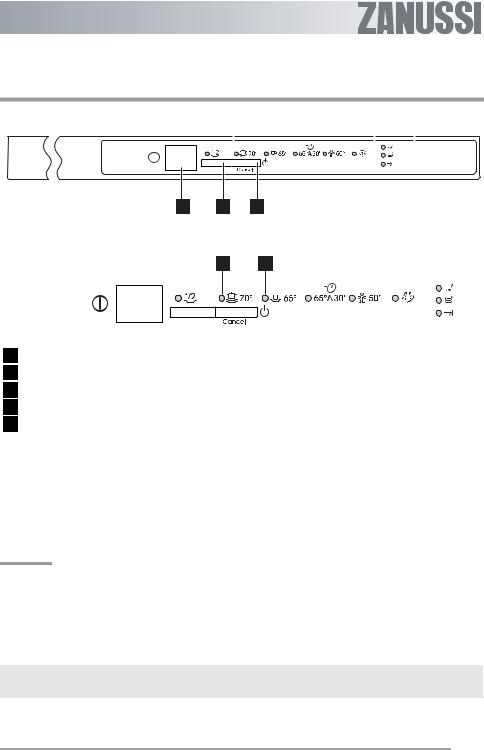
Bedienblende
1 2
A
1Ein-/Aus-Taste
2Taste "Halbe Beladung"
3Programmauswahl/-abbruch-Taste
4Kontrolllampe
5Programmkontrolllampe
Einstellmodus
Das Gerät befindet sich im Einstellmodus, wenn alle Programmanzeigen erloschen sind und die Kontrolllampe Programmende blinkt.
WICHTIG!
Denken Sie daran, dass der Geschirrspüler:
•beim Auswählen eines Spülprogramms
•Einstellung des Wasserenthärters
•Ein-/Ausschalten der akustischen Signale sich im Einstellmodus befinden MUSS.
Taste "Halbe Beladung"
|
|
|
|
|
|
|||
5 |
|
|
4 |
|||||
|
|
|
|
|
|
|
|
|
|
|
|
|
|
|
|
|
|
|
|
|
|
|
|
|
|
|
|
|
|
|
|
|
|
|
|
|
|
|
|
|
|
|
|
|
|
|
|
|
|
|
|
|
|
|
|
|
|
|
|
|
|
|
3
B
Wenn eine Programmanzeige leuchtet und die Kontrolllampe Programmende kontinuierlich leuchtet, ist das zuletzt ausgeführte Programm immer noch aktiv .
In diesem Fall muss das Programm gelöscht werden:
1.Drücken Sie die Programmauswahl/-ab- bruch-Taste, bis die Lampe des laufenden Programms erlischt und die Kontrolllampe
Programmende blinkt.
2.Geben Sie die Programmauswahl/-ab- bruch-Taste frei.
Diese Funktion kann nur in Verbindung mit der Auswahl eines Spülprogramms gewählt werden. Näheres
27

|
dazu finden Sie im Abschnitt "Programmtabelle". |
|
|
Wenn Sie diese Taste drücken, leuchtet die entspre- |
|
|
chende Kontrolllampe auf. |
|
|
Verteilen Sie das Geschirr auf beide Körbe (den obe- |
|
|
ren und den unteren). |
|
|
Verringern Sie bei dieser Funktion die Spülmittelmen- |
|
|
ge, die Sie gewöhnlich für eine volle Beladung ver- |
|
|
wenden. |
|
Programmauswahl/-abbruch-Taste |
• |
Starten des Spülprogramms: |
|
1. |
Drücken Sie die Ein-/Aus-Taste. |
|
2. |
Drücken Sie die Programmauswahl/-abbruch- |
|
|
Taste einmal. Die Kontrolllampe des zuletzt aus- |
|
|
geführten Spülprogramms leuchtet auf und die |
|
|
Kontrolllampe Programmende blinkt. |
|
3. |
Drücken Sie die Programmauswahl/-abbruch- |
|
|
Taste so oft, bis die Kontrolllampe für das ge- |
|
|
wünschte Programm aufleuchtet. |
|
4. |
Schließen Sie die Tür des Geschirrspülers. Das |
|
|
Programm startet automatisch. |
WICHTIG!
Wenn Sie nach dem Start des Programms ein anderes Programm auswählen möchten, müssen Sie das laufende Spülprogramm abbrechen.
• Abbrechen eines laufenden Spülprogramms:
1. Öffnen Sie die Tür.
2. Halten Sie die Programmauswahl/-abbruch-
Taste gedrückt, bis die Kontrolllampe für das laufende Programm erlischt und die Kontrolllampe
Programmende blinkt.
3. Lassen Sie die Programmauswahl/-abbruch-
Taste los.
4. Schalten Sie die Maschine mit der Ein-/Aus-Taste aus oder wählen Sie ein neues Spülprogramm. Kontrollieren Sie in diesem Fall, ob der Spülmittelbehälter gefüllt ist.
|
Kontrolllampen |
|
Spülkontrolllampe |
|
Leuchtet, wenn die Spülund Klarspülgänge sowie die |
|
|
Trockenphase laufen. |
28

|
Kontrolllampen |
|
Salzkontrolllampe |
|
Leuchtet auf, sobald Spezialsalz nachgefüllt werden |
|
|
muss. |
|
|
Leuchtet nie während laufender Spülprogramme. |
Kontrolllampe Programmende |
|
Leuchtet nach dem Ende des Spülprogramms auf. |
|
|
Dazu kommen weitere optische Signalfunktionen: |
|
|
– die Einstellung für den Wasserenthärter, |
|
|
– die Ein-/Abschaltung der akustischen Signale, |
|
|
– Alarm aufgrund einer Fehlfunktion der Maschine. |
|
|
|
Töne
Damit besser erkennbar ist, welche Operationen der Geschirrspüler ausführt, wurden Töne eingeführt.
–Für das Ende des Spülprogramms und für die
–Gerätestörung
Werkseitige Einstellung: Töne eingeschaltet. Die Töne können mit der Taste Programm- auswahl/-abbruch einund ausgeschaltet werden.
Ein-/Ausschalten der Töne
1.Drücken Sie die Ein-/Aus-Taste. Das Gerät muss sich im Einstellmodus befinden.
2.Drücken Sie die Programmauswahl/-ab- bruch-Taste, bis Programmkontrolllampe A blinkt und Programmkontrolllampe B kontinuierlich leuchtet.
3.Drücken Sie erneut die Programmaus- wahl/-abbruch-Taste: Programmkontrolllampe A leuchtet jetzt kontinuierlich und Programmkontrolllampe B blinkt.
4.Nach wenigen Sekunden:
–Programmkontrolllampe A erlischt
–Programmkontrolllampe B blinkt weiter
–Die Kontrolllampe Programmende leuchtet kontinuierlich und zeigt damit an, dass die Töne eingeschaltet sind.
5.Drücken Sie zum Abschalten der Töne erneut Taste Programmauswahl/-ab- bruch: Die Kontrolllampe Programmende erlischt und zeigt damit an, dass die Töne ausgeschaltet sind.
6.Schalten Sie den Geschirrspüler aus, um die ausgewählte Option zu speichern.
7.Zum erneuten Einschalten der Signaltöne wiederholen Sie die oben genannten Schritte solange, bis die Kontrolllampe
Programmende leuchtet.
29
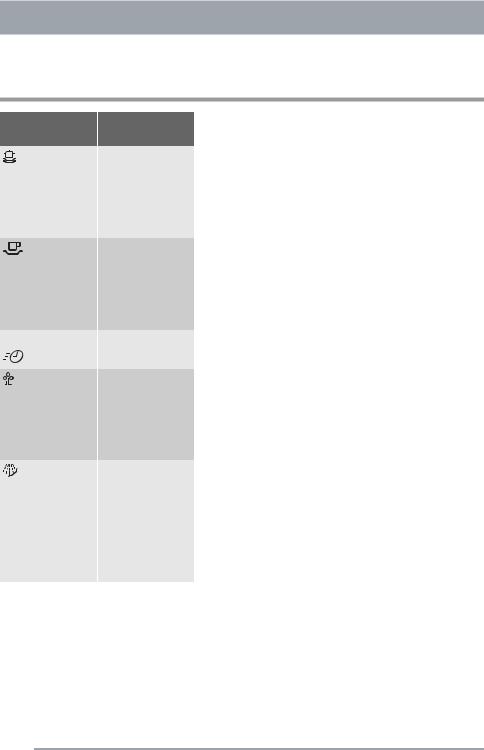
Spülprogramme
Programm
70°
65°
65° A 30' 2)
50° 3)
Halbe Beladung
Ja 1)
Ja 1)
Nein
Ja 4)
Nein
Grad der Ver- |
Spülgut |
Programmbe- |
schmutzung |
|
schreibung |
Stark verschmutzt |
Geschirr, Besteck, |
Vorspülgang |
|
Töpfe, Pfannen |
Hauptspülgang |
|
|
2 Zwischenspül- |
|
|
gänge |
|
|
Klarspülgang |
|
|
Trocknen |
Normal ver- |
Geschirr, Besteck, |
Vorspülgang |
schmutzt |
Töpfe, Pfannen |
Hauptspülgang |
|
|
2 Zwischenspül- |
|
|
gänge |
|
|
Klarspülgang |
|
|
Trocknen |
Leicht verschmutzt |
Geschirr und Be- |
Hauptspülgang |
|
steck |
Klarspülgang |
|
|
|
Normal ver- |
Geschirr und Be- |
Vorspülgang |
schmutzt |
steck |
Hauptspülgang |
|
|
1 Zwischenspül- |
|
|
gang |
|
|
Klarspülgang |
|
|
Trocknen |
Beliebig. |
|
1 Kaltspülgang (da- |
Teilweise beladen (weiteres Spülgut soll im |
mit die Speiserück- |
|
Lauf des Tages noch hinzukommen). |
stände nicht verkle- |
|
|
|
ben). |
|
|
Für dieses Pro- |
|
|
gramm ist kein |
|
|
Spülmittel erforder- |
|
|
lich. |
1)Wenn Sie die Taste "Halbe Beladung" drücken, wird der Vorspülgang automatisch übersprungen. Daher ist auch kein Spülmittel für den Vorspülgang erforderlich.
2)Ideal, wenn der Geschirrspüler nur teilweise beladen ist. Dies ist das perfekte tägliche Spülprogramm für eine 4-köpfige Familie, die lediglich das Frühstücksund Abendessensgeschirr samt Besteck spülen möchte.
3)Testprogramm für Testinstitute.
4)Wenn Sie die Taste "Halbe Beladung" drücken, wird die Spüldauer verkürzt.
30
